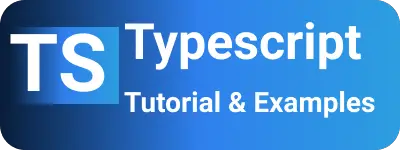Typescript Dictionary Complete Guide with examples
- Admin
- Mar 6, 2024
- Typescript
Typescript Dictionary Class: Learning with Examples
In this blog post, delve into the concept of dictionaries in Typescript through illustrative examples.
A dictionary is a data structure that contains unordered key-value pairs. It resembles the map type in Typescript.
Does TypeScript Have Dictionaries?
While Typescript does not explicitly offer a dictionary type, it provides the Map type, which serves the purpose of storing key-value pairs in an unordered manner. ES6 introduced the Map type, which can be utilized in Typescript by creating Map objects.
You can create a dictionary using Map as shown below:
Using new and Map keyword with key and value types are declared.
valid key and value types are string,number,boolean and class or interface objects.
let dictionary = new Map<string, string>();
How to Declare and Initialize a Dictionary in TypeScript?
A map is a type introduced in ES6, It adds type safety to key and values in typescript. It is an alias for Dictionary
the declare and create a map variable using new operator and key and value types are declared
let employees = new Map<string, string>();add the key-value pairs to an map using
setmethod.employees.set("name", "john");check for key exists or using
has()method
// Checking for the key exist :
employees.has("name"); // true
- get the value with a key using
getmethod.
// get a value by a key:
employees.get("name"); // john
- delete a key and its value using
deletemethod.
// delete an item by a key:
employees.delete("name");
- Iterate the map with keys and values using
forEachwith callback
// iterate key and values
employees.forEach((item, key) => console.log(item));
- Remove all elements(keys and value) from a map using clear() method
// remove all from map:
employees.clear();
- get the number of elements in a map
// size:Number of elements in Map :
console.log(employees.size);
- retrieve all keys and values with insertion order
// get All keys with insertion order
let keys = Array.from(employees.keys());
// Extract values with insertion order
let values = Array.from(employees.values());
Here is an complete example
let employees = new Map<string, string>();
employees.set("name", "john");
// Checking for the key exist :
employees.has("name"); // true
// get a value by a key:
employees.get("name"); // john
// delete an item by a key:
employees.delete("name");
// iterate key and values
employees.forEach((item, key) => console.log(item));
// remove all from map:
employees.clear();
// size:Number of elements in Map :
console.log(employees.size);
// get All keys with insertion order
let keys = Array.from(employees.keys());
// Extract values with insertion order
let values = Array.from(employees.values());
How to get key values from a dictionary in TypeScript?
following are steps required to get key values from a dictionary or map in typescript.
- one way using map.keys returns list of keys
- Another using for each
employees.forEach((item, key) => console.log(key));
How to iterate through keys in TypeScript Dictionary?
Multiple ways to return the keys of an map in Typescript
// iterate key and values
employees.forEach((item, key) => console.log(item));
How to declare an interface for a dictionary in typescript?
Declare an interface using indexable type in typescript
It accepts a key as a string and value of type T
interface Dictionary<T> {
[key: string]: T;
}
A class contains properties of the dictionary interface as below.
export class AllEmployees {
employees: Dictionary<string> = {};
}
Dictionary interfaces declare with let keyword and initialize the values, add the values.
let emps: Dictionary<string> = {};
emps["name"] = "john";
How to declare a dictionary with record type in typescript
The Record type in Typescript is used to represent a map of key-value pairs. You can declare a dictionary using the Record type.
type emps = Record<string, string>;
Then, you can initialize the dictionary with data as follows.
let emps: Record<string, string> = {
{"name": "john" },
{"id": "1" }
};
Conclusion
This post provided comprehensive examples on how to work with dictionaries in Typescript, including declaring interfaces and utilizing the Record type. Dictionaries offer a convenient way to manage key-value pairs in Typescript applications.
